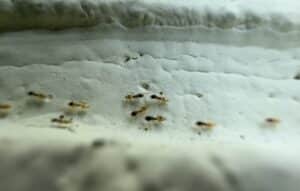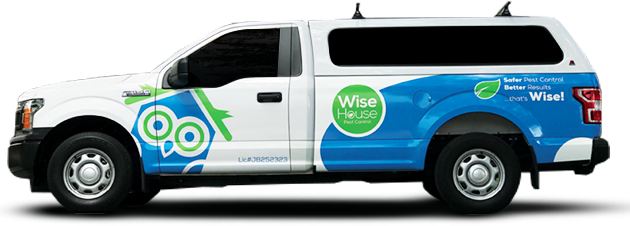Beneath Florida’s sun-soaked skies, an insidious army of tiny invaders marches unnoticed into homes and businesses alike. Ghost ants, nearly invisible at just 1.5 millimeters long, blend seamlessly into their surroundings with their translucent bodies. But don’t let their size and subtlety fool you, these pests can quickly become a major headache, wreaking havoc in kitchens, bathrooms, and even electrical systems.
If you’re a Florida resident, chances are you’ve encountered these elusive pests. In this post, you will know everything about ghost ants, revealing their hidden habits and vulnerabilities. You’ll learn how to spot the telltale signs of an infestation and discover proven methods to reclaim your space from these persistent pests. Whether you’re dealing with a minor incursion or a full-blown infestation, we will equip you with the knowledge and strategies you need to know!

Ghost ants, scientifically known as Tapinoma melanocephalum, are a common household pest in South Florida. These minuscule ants, typically measuring 1.3 to 1.5 millimeters, are characterized by their pale, almost translucent bodies, with darker heads and thoraxes. This coloration, along with their small size, makes them particularly difficult to spot, hence their name.
Ghost ants thrive in Florida’s warm, humid climate, and are known to establish nests both indoors and outdoors. Indoors, they may nest in wall voids, behind baseboards, or even within appliances. Outdoors, they can be found in soil, under rocks, or in decaying wood.
While not inherently dangerous, ghost ants are considered a nuisance pest due to their propensity to invade homes and contaminate food sources. They are attracted to sweets and proteins, making kitchens and pantries particularly vulnerable. Additionally, their large colony sizes, which can contain multiple queens, make them difficult to control.
Recognizing ghost ants can be tricky due to their minuscule size and translucent appearance. However, several key features can help you differentiate them from other ant species common in South Florida:
Size – Ghost ants are tiny, measuring only 1.3 to 1.5 millimeters in length.
Color – Their bodies are bi-colored. The head and thorax are dark brown or black, while the abdomen and legs are pale, almost translucent, giving them a “ghostly” appearance.
Movement – Ghost ants are known for their erratic and rapid movements. They often scurry quickly and change direction abruptly, making them difficult to track.
Nesting Habits – Ghost ants typically nest in warm, humid areas, both indoors and outdoors. Inside, they may be found in wall voids, behind baseboards, or under appliances. Outside, they often nest in soil, under rocks, or in decaying wood.
Trails – Ghost ants often travel in trails, especially when foraging for food. These trails may be visible as a line of ants moving along a surface.
Sweet Tooth—Ghost ants prefer sweet foods and may be found near sugary substances in kitchens and pantries.
By paying close attention to these characteristics and observing their behavior, you can accurately identify ghost ants in your South Florida home or business. Early identification is important for effective pest control management.
Please note that if you are unsure about an ant infestation, it’s always recommended to consult with a pest control professional for accurate identification and appropriate treatment.
Beyond their very small size and translucent bodies, ghost ants possess intriguing biological traits and complex behavioral patterns that contribute to their resilience and proliferation.
One of the most remarkable aspects of ghost ant biology is their polydomous nesting behavior. Unlike many ant species that maintain a single central nest, ghost ants establish multiple interconnected nests, both indoors and outdoors. This decentralized approach provides several advantages, including increased access to food sources, protection against environmental fluctuations, and enhanced survivability in the face of threats.
Within these interconnected nests, ghost ants exhibit a unique social structure characterized by polygyny, the presence of multiple queens within a single colony. This reproductive strategy allows for rapid population growth and colony expansion, making them particularly challenging to control in some cases.
Ghost ants are opportunistic feeders, displaying a diverse diet that includes both sugary and protein-rich foods. They are particularly fond of honeydew, a sugary secretion produced by aphids and other plant-sucking insects. To access honeydew, ghost ants often engage in mutualistic relationships with these insects, protecting them from predators in exchange for the sweet reward.
In addition to honeydew, ghost ants also readily consume nectar, fruits, and other sweet substances. They are not averse to scavenging for protein sources either, feeding on dead insects, grease, and even pet food. This adaptability in their diet contributes to their ability to thrive in various environments, including urban and suburban settings.
Ghost ants employ efficient foraging strategies to locate and exploit food sources. They typically travel in trails, following pheromone trails laid down by scout ants. These trails lead to food sources and back to the nest, allowing for efficient transport of food and communication between colony members.
Ghost ants are renowned for their adaptability and ability to thrive in diverse habitats. They readily colonize both natural and artificial environments, establishing nests in soil, leaf litter, wall voids, and even electrical outlets. This flexibility allows them to exploit a wide range of resources and adapt to changing environmental conditions.
Their resilience is further enhanced by their ability to rapidly reproduce and disperse. The presence of multiple queens within a colony ensures that even if some individuals are eliminated, the colony can quickly recover and continue to thrive. This makes ghost ant infestations particularly challenging to eradicate, as traditional pest control methods may not be sufficient to eliminate all reproductive individuals.
Starve Them Out – Ghost ants are relentless foragers with a particular weakness for sweets. Eliminate their food sources by meticulously cleaning up spills, storing food (including pet food) in airtight containers, and wiping down surfaces regularly. Don’t forget to address outdoor attractants like fallen fruit or open trash bins.
Seal the Fortress – Ghost ants are masters at infiltration, exploiting even the tiniest cracks and crevices. Conduct a thorough inspection of your home, focusing on areas where pipes and wires enter, and seal any gaps with caulk or other suitable materials.
Disrupt Their Communication – Ghost ants use scent trails to locate food. Disrupting these trails can disorient them and impede their ability to return to the nest. Utilize natural deterrents like vinegar, citrus peels, or essential oils (peppermint, cinnamon, clove) along their paths.
Call in the Professionals – If DIY methods prove insufficient or the infestation is widespread, don’t hesitate to seek professional pest control services. Experienced pest control technicians possess the knowledge, expertise, and specialized tools to accurately identify and eradicate ghost ant colonies, ensuring long-term relief.
Maintain a Vigilant Defense – Once the infestation is under control, implement preventive measures to deter future invasions. This includes regular cleaning, sealing potential entry points, and continuing to use deterrents to disrupt ant trails. Remember, consistency is key to maintaining a ghost ant-free environment.
By implementing these practical strategies, you can effectively address ghost ant infestations and reclaim your South Florida home from these pests.
While they do not bite or sting, South Florida Ghost Ants can contaminate food and surfaces, potentially spreading bacteria and causing foodborne illnesses.
Follow ant trails to locate nests, often found in wall voids, behind baseboards, or in moist areas. Outdoor nests are commonly found in mulch, soil, or plant debris.
Avoid using repellents that scatter ants, neglect to address moisture sources, and fail to use bait traps effectively.
While they are not known to cause significant damage to wiring, they can nest in electronic devices, potentially causing malfunctions.
Infestations often increase in spring and summer due to warmer and wetter conditions that promote ant activity and nesting.
Yes, essential oils like peppermint, citrus, and tea tree oil can deter ants. Mix with water and spray around entry points and nesting areas.

Ready to send away pests without harming your pets? Getting started with Wise House Environmental Services is as easy as 1-2-3:
With Wise House Environmental Services, you get more than just effective pest control; you get peace of mind, knowing that your home is without pests and safer for your pets.
Our approach to pest control combines science with safety, offering you the kind of targeted, effective solutions that you won’t find with just any other pest control service. Our services have made a world of difference for homeowners, and we can do the same for you. Your pets will thank you for it!
We serve Port St. Lucie,Lake Worth, Boyton Beach, Palm Beachand the Treasure Coast.


© 2023 All Rights Reserved. | Sitemap